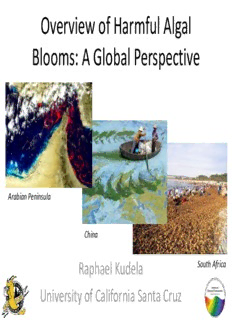
Overview of Harmful Algal Blooms: A Global Perspective PDF
Preview Overview of Harmful Algal Blooms: A Global Perspective
Overview of Harmful Algal Blooms: A Global Perspective Arabian Peninsula China Raphael Kudela South Africa University of California Santa Cruz Summary & Key Points • HABs result from noxious and/or toxic algae that cause direct and indirect negative impacts to aquatic ecosystems, coastal resources, and human health. • HABs are present in nearly all aquatic environments as naturally occurring phenomena. • Many HABs are increasing in severity and frequency, and biogeographical range. Some of this expansion is attributed to climate change and global change. • Research has improved understanding, leading to better prediction and monitoring, and potentially, mitigation. • HABs are a worldwide phenomenon requiring international understanding leading ultimately to local and regional solutions. • HABs must be integrated with policy decisions. • HABs result from noxious and/or toxic algae that cause direct and indirect negative impacts to aquatic ecosystems, coastal resources, and human health 0 - 7 1 0 0 0 . 0 , s - r 3 e 8 t 4 s a 6 s 9 i 3 D - 2 & 1 , - s 0 k - s 8 i 7 R 9 , B s d / 6 r a 1 z 0 a 1 H . 0 e 1 n / i g r a r o M . i o & d . l x a d t s / a / o :p C t t , h . l a 5 t 1 e 0 2 n o r s e r i e v e d s n l A E , 3 1 3 0 4 2 - 3 s w 2 . e x iv .0 e 0 R 0 2 y 1 g . o 2 l 1 o 0 i b 2 o . 6 r c 7 i 9 M 6 - S 4 M 7 5 E 1 F . ,. j/ l 1 a 1 t 1 e 1 n . 0 a 1 m : t I t O i D D “…this has been the deadliest red tide for state abalone in at least three decades.” Press Democrat, 7-Sep-11 Blooms and Water Quality are Linked September 2009—53 year old woman diving in Monterey suffered from bilateral mastoiditis (ear infections penetrating to the brain). Retrospective analysis linked high pathogen loads to red tides. Honner, Kudela & Handler (2012), J. Emergency Medicine Jessup et al. 2009, PLoS-ONE
Description: